How Semiconductors Will Innovate the Future: Our Society in 2040 as Envisioned by High School Students in Sapporo
Culture
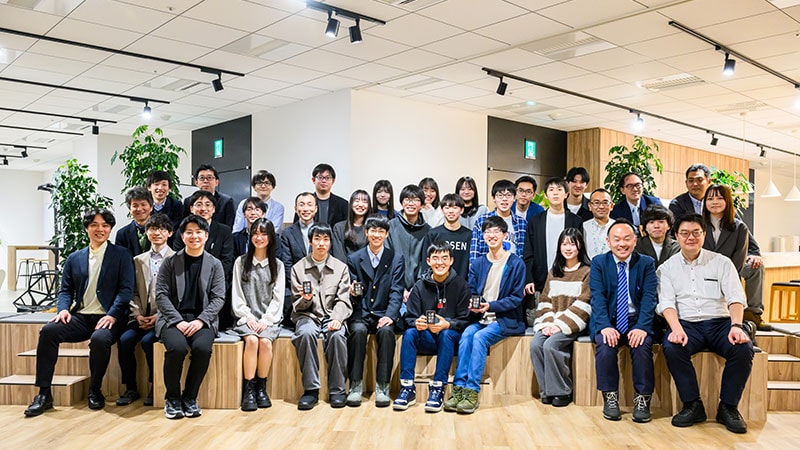
Cloud/edge computing, IoT, Industry 4.0, AI, autonomous driving, AR/VR—at the heart of all these technologies are semiconductors. The semiconductor market is expected to nearly double its current size by around 2030, and its growth potential is simply enormous. What the industry needs right now is a talent pool to support this growth.
Tokyo Electron (TEL) is making various efforts to develop a skilled workforce, including industry-academia partnerships and internship programs. The following is a report on a guest class that the company recently hosted for students at Sapporo Asahigaoka High School. With the theme “A Future Enabled by Semiconductor Innovation,” the students were divided into discussion groups. What kind of future society did they come up with? Let’s find out!
Learning about Today’s Semiconductors and What It Means for Hokkaido
As a first step, the participants learned the basics of semiconductors from different angles.
TEL’s Shota Yamada gave the first lecture titled “What is a semiconductor?” As an Associate Professor, Yamada skillfully explained that semiconductors power various electronic applications such as smartphones, AI, automobiles, satellites, etc., earning the nickname “a staple of industry.” He then explained in simple terms how the semiconductor manufacturing processes work.
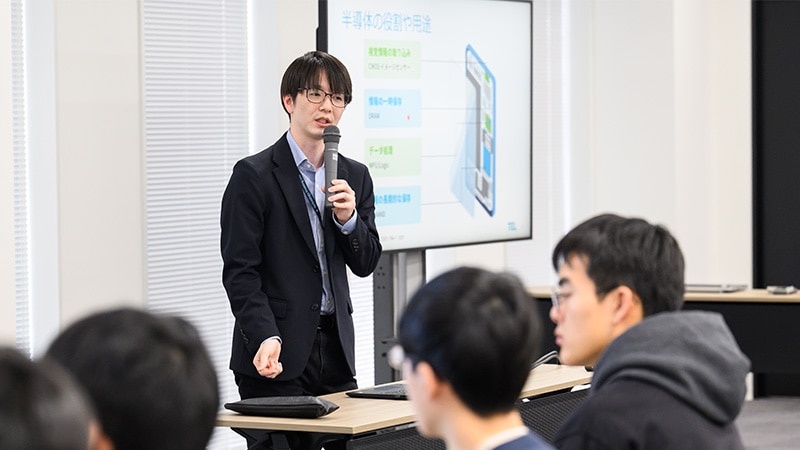
To illustrate the extreme precision required in the nano-processing of semiconductors, Yamada compared a 30 cm diameter wafer to the island of Hokkaido, which stretches about 300 km from east to west. Producing circuit features of about 2 nm on the wafer is like forming line structures 2 mm wide —no thicker than a pencil lead—across the vast expanse of Hokkaido. A real wafer was passed around the room to help students understand the intricacies of semiconductor manufacturing. Holding a dark, mirror-like wafer—a very rare experience in itself—one student said it was fascinating that semiconductor chips made from such a thin slice could power various electronic applications. Another commented that comparing tiny features on a wafer to pencil lead and Hokkaido was very intuitive.
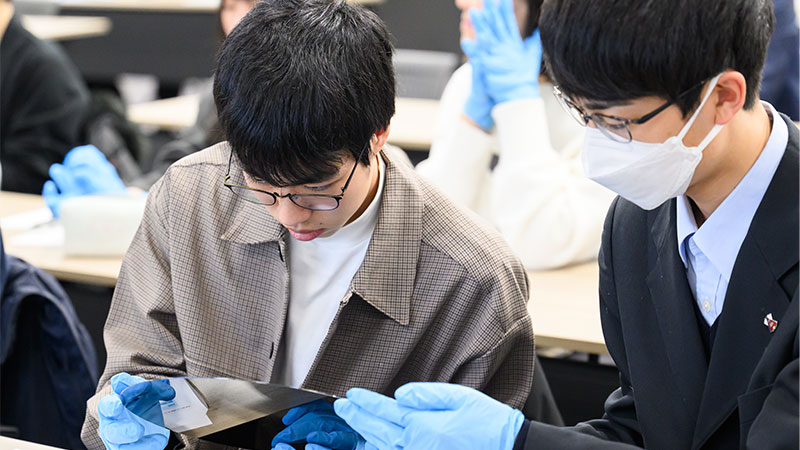
The next speaker was Kento Igarashi, who works on AI-based development of semiconductor production equipment at TEL. In a lecture titled “Semiconductor & Hokkaido,” he pointed out that Hokkaido meets many of the requirements for semiconductor manufacturing, such as large land areas, abundant groundwater, excellent transportation infrastructure, and great potential for renewable energy generation. He noted that semiconductors could become a key industry in Hokkaido and that the demand for workers in the semiconductor industry would continue to grow.
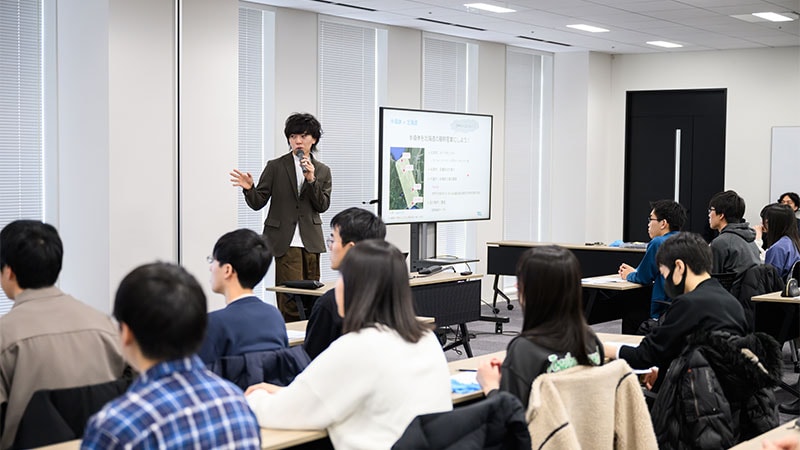
The topic that piqued the students’ interest the most was the question of their future paths. Both seniors who have already taken the college entrance exams, and freshmen who are just beginning to think about their future paths, were equally intrigued for different reasons. After naming some universities and departments that offer semiconductor courses, Igarashi said that when it comes to working for a semiconductor company, it does not really matter what you majored and studied, but what matters is whether they have a strong interest in semiconductors. Because a semiconductor is the product of knowledge from many disciplines, there are countless opportunities to apply what one has learned as a student, whether it is chemistry, robotics, data science, economics, or other disciplines that may seem completely unrelated to semiconductors. The lecture appears to have inspired some students to consider a career in semiconductors as a realistic option.
The final speaker, Professor Takashi Yamada of the Chitose Institute of Science and Technology, talked about the theoretical and mechanical building blocks of semiconductors, including conductive materials, circuits, and logical operation symbols. “You may find these ideas difficult to grasp, and I don’t blame you, but even a glimpse through the doorway of learning will hopefully stimulate you,” said Professor Yamada. Despite some advanced elements of the lecture, some students seemed excited. “I’m looking forward to going to college so I can understand these concepts,” said one, while another said, “I don’t know how it really works, but semiconductor technology is amazing!”

Group Work: Imagine a Technologically Advanced Future 15 Years from Now
The main feature of the day’s program was group work, where students were divided into four groups to discuss the theme “Semiconductor Technology Will Advance to Become (or Enable) xxxx by 2040” and present their visions of the future.
As soon as the discussions began, all four groups were buzzing with excitement. The topic that elicited the most lively responses was “A Future That Is Almost Here.”
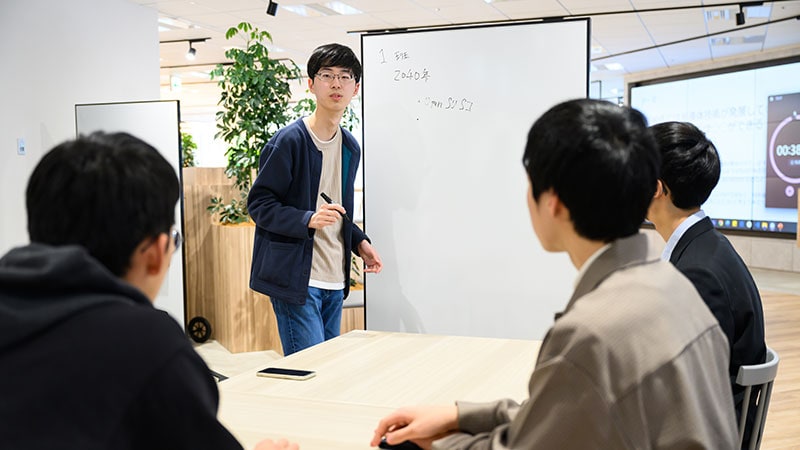
Think, for example, advances in semiconductors and electronic devices are likely to lead to even smaller and more energy efficiency. “Of course, wearable electronics will get even smaller. We already have smart rings and other small wearables that can handle electronic payments, and if we take it a step further, we may be able to implant tiny but even more useful devices inside our bodies for various medical purposes. These implanted devices could monitor vital signs, deliver medication, or even assist in the management of conditions,” said a member of Group 1, much to the excitement of everyone.
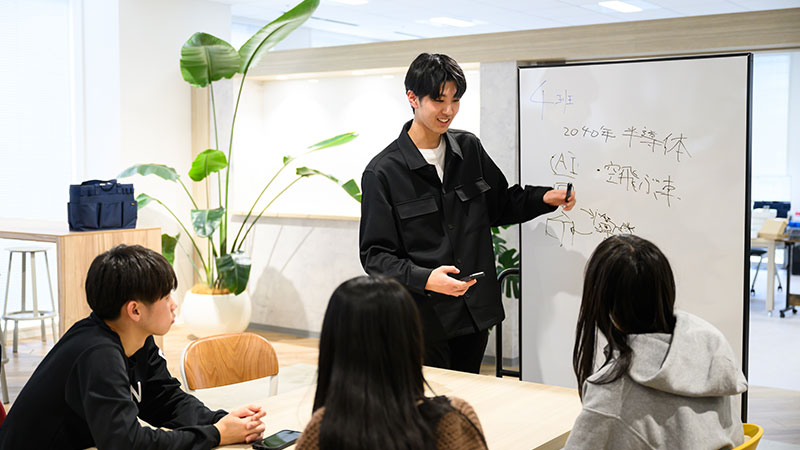
Group 3 members focused on the ever-increasing speed of data processing and storage capacity. Meanwhile, Group 4 considered further advances in edge AI (where AI is deployed on local edge devices without relying on the cloud) and brainstormed about its potential applications. One member suggested a wild bear detection system, an intriguing idea that could solve a problem plaguing locals.
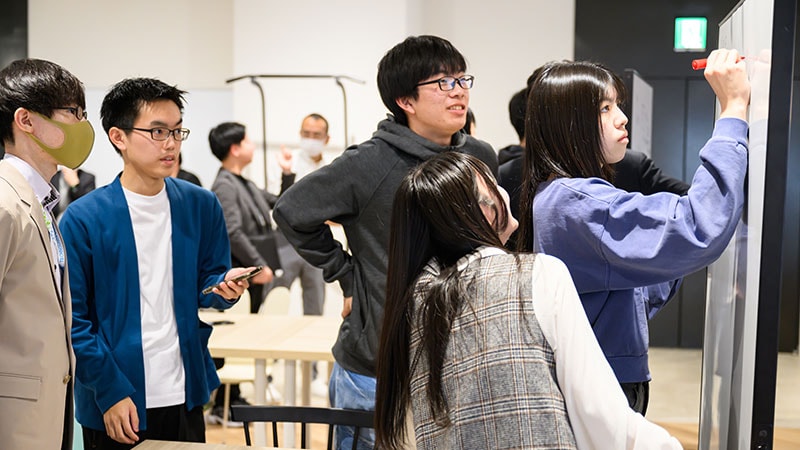
The members of Group 2 turned their attention to the fact that advances in semiconductor technology have solved various social problems. Assuming that practical flying cars would be built in the near future, the members began to list social problems that could be solved by such vehicles. Referring to a set of Sustainable Development Goals (SDGs), they discussed what kind of social contribution flying cars could make.
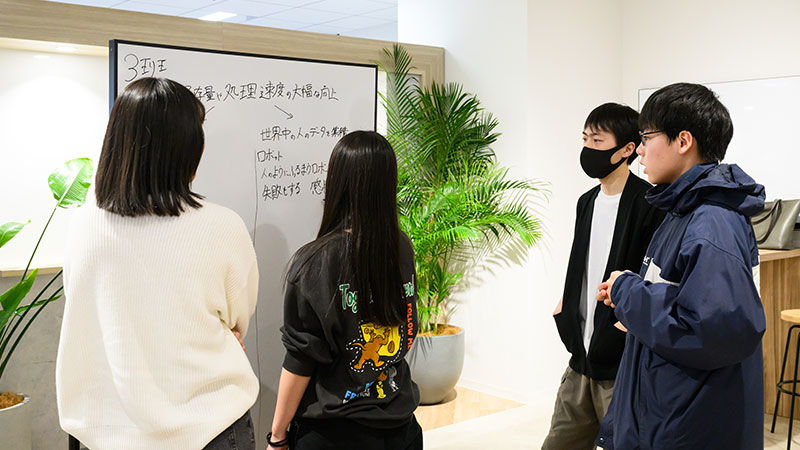
As the discussions progressed, a nagging question emerged: “The enabling technology may be developed, but can we really turn our ideas into acceptable products?” Each group had to face legal and ethical issues associated with new technologies.
Five-Sense Devices, Flying Cars: the Future Is Almost Here
After nearly three-quarters of an hour of heated discussions, each group made a presentation. How do they see the world 15 years from now?
Group 1: We Can Access and Control Our Senses by 2040!
In the 15 years between 2010 and 2025, advances in the Internet and smartphones have brought distant events a little closer. For example, in 2010 it was not easy to see a live image of the Statue of Liberty from home, but now it is available to anyone with a live camera or video call connection.
As semiconductors continue to shrink over the next 15 years, many electronic devices will be small enough to be implanted in our bodies. It may then be possible to access and manipulate our five senses and make us perceive a variety of things in a “truly real” way. This is the idea behind the vision of the Brain-Machine Interface (BMI) presented by Group 1.
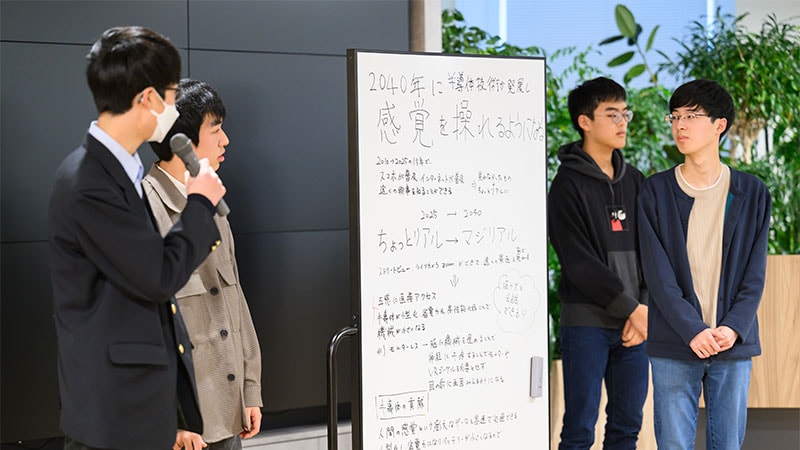
“It is said that the human eye sees things at a resolution equivalent to an 8K TV. At the rate technology is advancing, we will soon be able to process this amount of data very easily and quickly. In addition, technologies that manipulate our senses are already being developed, such as a spoon that uses a weak electric current to enhance the perceived saltiness and umami of food,” the presenter said, citing specific examples.
“Music is another area where significant progress has been made. In 2010, people regularly borrowed CDs and transferred the data to the iPod with a cable before listening to the songs, which seems quite cumbersome today. No one could have imagined that electronics would have come this far in 15 years. If so, imagine the evolution that awaits us in 2040! So, we let our imaginations run wild as we approached this subject,” the presenter concluded.
Group 2: Flying Cars Will Be Everywhere by 2040!
Group 2 members discussed the types of social problems that flying cars can solve, highlighting two modern issues: the scarcity of on-demand mobility in the event of a disaster, and the environmentally unfriendly nature of automotive power sources.

“Flying cars can be easily deployed in disaster situations and can access deep mountainous areas that helicopters cannot. They don’t need to stop at traffic lights, which reduces energy waste. Advances in semiconductor technology will lead to powerful Artificial General Intelligence (AGI) and Innovative Optical and Wireless Network (IOWN) infrastructure, accelerating the development of viable flying cars that solve many social problems,” said the Group 2 presenter. Based on a news report that Toyota is developing flying cars, the presenter estimated that the production technology would be in place by 2040.
“Compact, safe, and eco-friendly: the most versatile mobility solution” was the slogan Group 2 used to promote flying cars. The group’s idea of using AGI and its willingness to apply new technologies to solve social problems received high marks.
Group 3: The Convenience of Robotic Technology Will Increase by 2040!
Group 3 members discussed the specific applications and challenges brought about by advancements in robotic technology.
“One day, artificial hearts, arms, legs, eyes, and other prosthetic devices will be able to receive and respond to signals from the brain, improving the quality of life for their users. By aggregating biometric data from people around the world, it may be possible to create robots with emotions that are human enough to make mistakes from time to time. But there will also be new problems.” said the Group 3 presenter, raising some legal and ethical questions.
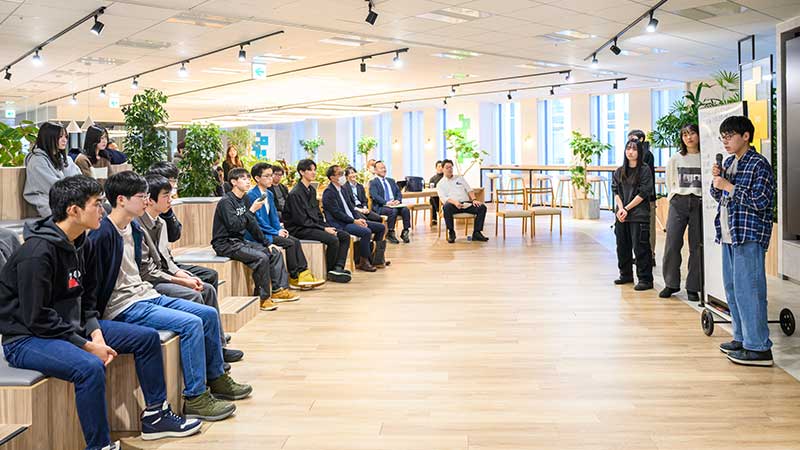
Group 4: Edge AI Will Become the Norm in Society by 2040!
In contrast to Group 1’s grand vision, Group 4 focused on ideas that are more likely to be part of our lives by 2040. Inspired by a member who was interning at an edge AI company, the group tried to figure out how edge AI—a hot technology that is already in the pipeline—could be applied in real life by 2040.
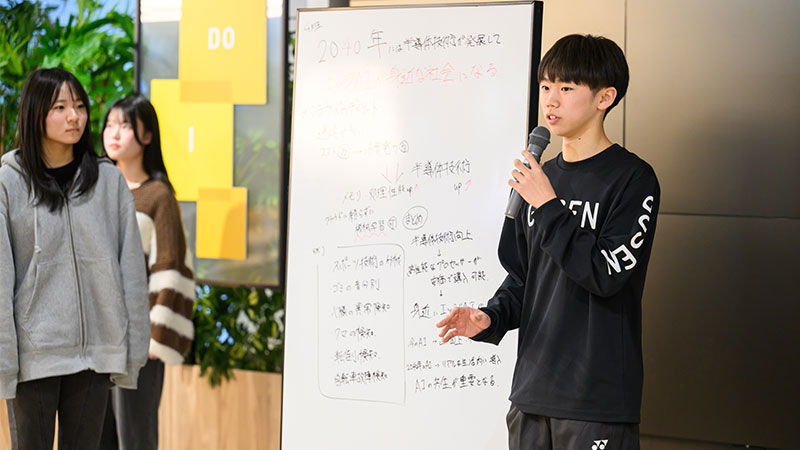
“Unlike today’s AI, which typically uses cloud computing, edge AI performs relatively small amounts of processing within the edge device itself, with shorter latencies and lower power consumption. With memory chips and CPU performance expected to improve significantly by 2040, edge AI is likely to be used in a wide range of applications. Examples include a tennis training app that analyzes the sound of a racket hitting a ball and provides precise performance tips, and a health app that monitors heart sounds to detect irregularities. Edge AI will be invaluable in areas where real-time response is critical,” the presenter suggested, staying on solid ground. Using “AI-human symbiosis” as the key concept, the group envisioned a promising future where AI is part of everyday life.
Semiconductors Bring a Bright Future to Young Generations
The four thought-provoking presentations were then evaluated by TEL’s Hironori Moki, Vice President, Equipment Intelligence & Application Development Dept., Professor Takashi Yamada of the Chitose Institute of Science and Technology, and Mr. Yasunori Sakaniwa, a teacher at Sapporo Asahigaoka High School. “Kudos to all of you for having fruitful discussions and making great presentations in such a short time,” said one judge, and others agreed. The winner was Group 1, who presented a vision of advanced BMIs that can control our five senses. As a reward, the members received TEL’s original “element symbol card game” and a big round of applause.
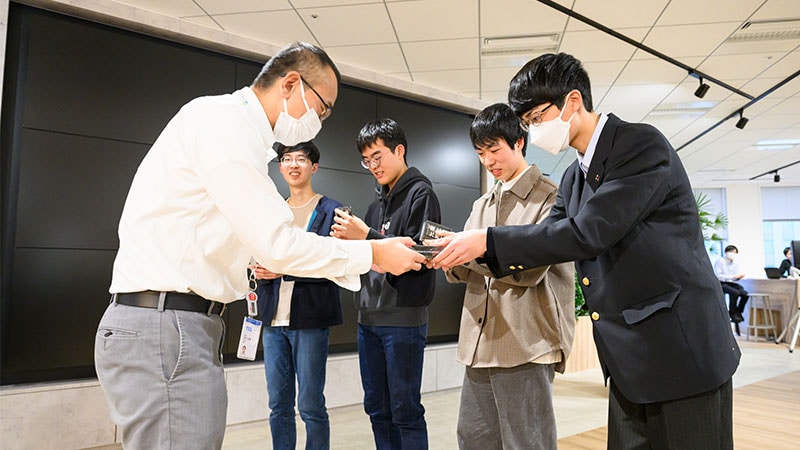
At the end of the event, the students toured the rest of the office and then mingled with others. Some students challenged the TEL employees present with a game of element symbol cards they had just received, adding to the friendly atmosphere.
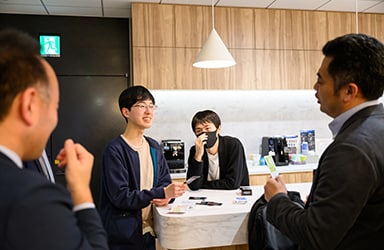

The students seemed very pleased with the event. “I must admit I didn’t know much about semiconductors, but this was exciting! The office is very nice, too. I’d like to work in a place like this,” said one, while another noted, “I had a vague idea that semiconductors were some amazing stuff in the machines, but listening to the developers’ talks and imagining our future with advanced semiconductors really made me curious.”
Although semiconductors have evolved at an astonishing rate, some say the physical shrinking that has driven their progress is reaching its limits. Of course, similar claims have been made many times before, only to be proven wrong. “Our mission is to overcome these limitations by continuously improving semiconductor manufacturing equipment in line with the industry’s technology roadmap,” TEL’s Yamada said in his lecture. As semiconductors become more powerful, the scope of their potential applications will expand. The task of realizing the future envisioned at this event is not only for the current generation of semiconductor workers, but also for the generation of bright-eyed students in today’s group work who will lead this industry for years to come.



